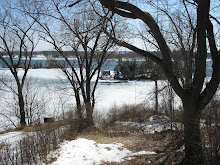If you have numb legs and/or feet and your doctor can't figure out why, consider an arteriovenous malformation (AVM). An MRI with contrast die is the diagnostic tool for this.
It's been a loooooooooooooooong six months. In the spring I was diagnosed with benign prostatic hydoplasia as a result of an ultra-sound and lower spine x-rays. In May I had a pretty significant fall on my dock which bruised and numbed my right leg and foot. The numbness continued and was also noticeable in my left foot. In June I first noticedwhat I would call 'wobbly legs - very occasional unpredicatable muscle behaviour which would affect my walking. I also found kneeling awkward. By the end of June my legs and feet were numb but super-sensitive to touch and temperature. A wet dog rubbing across my legs felt like hot oil being splashed. The numbness and weakness continued to increase and by July 1st I was using a cane to walk.
Another visit to my family doctor resulted in a consultation with a neurologist, a urologist, and an MRI of the lower spine. These consultations took their course and eventually I went to St. Mary's of the Lake hospital for conduction tests - the tests ruled out peripheral neuropathy and pointed higher in the spine. Meanwhile the urologist was checking out the bladder and prostate and could find no problems other than a lack of 'sensation of fullness'. I could have told him I was numb without him putting two litres of fluid in my bladder.
Several appointments with the family doctor and another consultation with the neurologist resulted in a die-enhanced MRI of the entire spine and brain. Within hours the problem was found. A spinal dural arteriovenous fistula is causing congestion of blood around my spinal cord. The list of symptoms describes me exactly and the MRI clearly shows the congestion of the cord. Everyone was ecstatic because this condition takes, on average, two years to successfully diagnose. Prompt diagnosis and treatment can mean full recovery.
I got an appointment within three weeks at Toronto Western Hospital for a catheter angiogram and, if possible, embolization of the artery by 'The Glue Man' Dr. Karel terBrugge. Unfortunately, the fistula is in the artery connected to the main artery serving the spinal cord and embolization is not safe because of the high risk of paralysis. Under most circumstances, a surgeon would then , within a few days, tie off the offending vessel with the same result. Unfortunately, in my case, both surgeons who could perform this surgery were out of the country so home I went.
Two weeks later the surgeon's office called with an appointment for a consultation two weeks later and then surgery sometime in the future. This is frustrating because the fistula was found much earlier than usual and my condition continues to deteriorate as I wait for treatment. In early November everybody was high-fiving about diagnosing the problem and it now looks like treatment may be delayed for three months.
The main purpose of this post is not so much to inform family and friends of progress but to create an internet presence of my experience for the benefit of others. When I was googling numb legs and other symptoms, I never once came across a mention of SDAVF or spinal dural ateriovenous fistula - if I had, I would have gone running to my doctor insisting on a full MRI. Promptness of diagnosis and treatment is crucial to complete recovery. This condition is very rare and not likely on your doctor's list of things to consider.
If you are suffering numb feet, numb legs, arms, hands, hypersensitive skin, numbness to the midsection (especially when sitting), lower back pain, aching hips, difficulty walking, difficulty lifting your feet - ask you doctor to consider an arteriovenous fistula. Although these symptoms may not appear all at once, they will get progressively worse and only treatment will put an end to it.
I would be happy to answer questions and hear your comments.
Tuesday, 21 December 2010
Subscribe to:
Comments (Atom)
